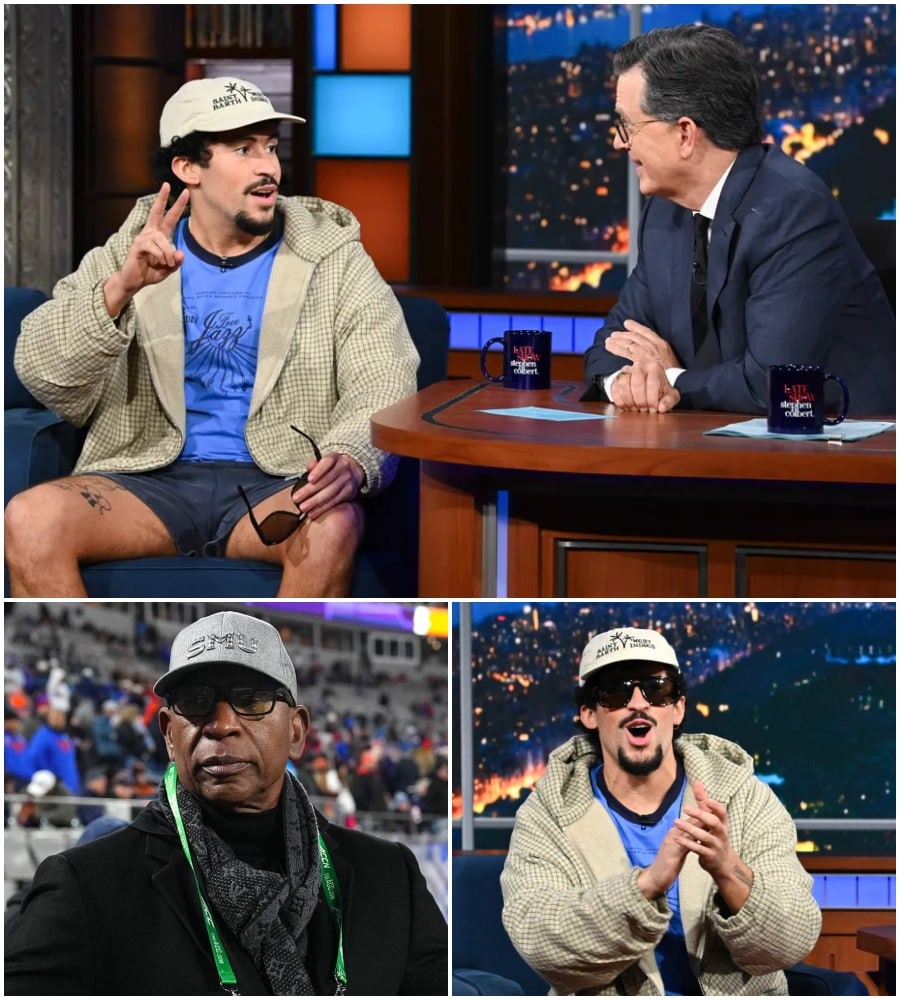America in the Spotlight: The Eric Dickerson–Bad Bunny Clash That Sparked a National Conversation About Identity, Patriotism, and the Soul of the Super Bowl
It started, as so many cultural earthquakes do, with an offhand remark caught on camera.
NFL Hall of Famer Eric Dickerson, fresh off a flight at Los Angeles International Airport, was asked a simple question by a reporter: what did he think about the rumor that Bad Bunny, the global superstar from Puerto Rico, might headline the 2026 Super Bowl halftime show?
No one expected what came next.
“I’m from the U.S.,” Dickerson said firmly. “I love my country. And if you don’t like the United States, just stay where you are. Don’t come here.”
The moment, brief and unscripted, spread within hours. The words struck a nerve that reached far beyond the world of sports and music. Suddenly, a retired running back and a genre-bending pop icon were at the center of a nationwide debate — one that wasn’t really about either of them, but about America itself.
Was this patriotism or prejudice? Respect for national pride or resistance to cultural change?
Whatever it was, the question refused to fade.

The Clash of Icons
To understand why the comment resonated so deeply, it helps to understand the men behind it.
Eric Dickerson, one of football’s all-time greats, built his career on grit and power. His record-breaking 1984 season still stands as one of the defining achievements in NFL history. Off the field, he’s known for his blunt honesty — a man who calls things as he sees them, unfiltered. To his admirers, he represents a vanishing archetype: the proud, old-school athlete who speaks from the heart, no matter the fallout.
Across the cultural divide stands Bad Bunny, a 30-year-old artist who has upended every notion of what a pop star can be. Born Benito Antonio Martínez Ocasio, he rose from Puerto Rican trap clubs to the top of the Billboard charts, singing almost entirely in Spanish. His concerts sell out stadiums across continents. He wears skirts, paints his nails, champions inclusion, and performs with the swagger of someone who refuses to fit any box.
To millions of fans, he embodies a new kind of American dream — one that transcends geography, language, and labels. To others, his outspoken politics and refusal to conform can feel, well, challenging.
When Dickerson’s comments circulated, the country split into familiar camps. Some praised him for defending tradition and “saying what others were afraid to.” Others saw his words as outdated, even dismissive of Puerto Rico’s deep ties to the United States.
The Halftime Show: America’s Mirror
The Super Bowl halftime show has always been more than just a concert. It’s a mirror held up to America, reflecting its values, its diversity, and sometimes its divisions.
In the 1990s, it was about pop spectacle — fireworks, choreography, and safe, crowd-pleasing acts. By the 2000s, it had become a showcase for reinvention: Prince, Madonna, Beyoncé, Shakira, The Weeknd, Rihanna, Usher. Each performance told its own version of America — bold, creative, sometimes controversial.
And yet, despite the diversity on display, the halftime show remains a cultural battleground. Every year, critics debate not just the music, but what the performance says about the nation itself. Is it too political? Too sanitized? Too global?
When rumors began that Bad Bunny might headline, the reaction was immediate and polarized. To his supporters, it felt like a historic step — the first Latin artist to lead the show solo, representing a generation that sees “American” as a tapestry, not a monolith. To his detractors, it symbolized something else: the loss of what they view as the show’s traditional American character.
Two Versions of Patriotism
Eric Dickerson’s comments, stripped of the shock value, represent a worldview that many Americans still hold dear — one that equates patriotism with loyalty, gratitude, and reverence for national symbols. In that framework, the Super Bowl halftime show isn’t just entertainment; it’s an honor, a ceremony that belongs to those who reflect American pride without ambivalence.
Bad Bunny, meanwhile, represents an entirely different understanding of what it means to belong. His version of patriotism — if you can call it that — is rooted in authenticity rather than conformity. He doesn’t pledge allegiance with slogans; he does it by being unapologetically himself, blending Puerto Rican identity with global influence.
When he once joked that fans should “learn Spanish” before his show, many took it as arrogance. But others saw it as a challenge — not a rejection of America, but an invitation to expand it.
To older generations, Dickerson’s brand of pride feels like respect. To younger ones, Bad Bunny’s self-expression feels like freedom. Both claim love for the same country — they just speak different cultural languages.
The NFL’s Dilemma
Caught between these two visions of America is the National Football League, a multibillion-dollar institution that has long struggled to balance tradition and transformation.
On one hand, the NFL is steeped in Americana — the anthem, the flyovers, the flag. On the other, it’s a business that thrives on global expansion and pop culture relevance.
Booking a performer like Bad Bunny would be a bold step toward the future: young, international, forward-looking. It would also risk alienating traditional fans who see the Super Bowl as sacred national ground, not a platform for cultural experimentation.
“The Super Bowl halftime show is the one moment when America stops arguing and just watches,” says media analyst Jennifer Miles. “But that’s exactly why it’s so fragile. Whoever stands on that stage becomes the face of the country — for better or worse.”
The league, sources say, is weighing those optics carefully. The decision is not just about who can sing or dance — it’s about what message the NFL wants to send to the world.

